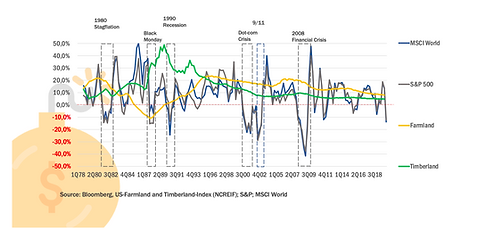
"BUY LAND
THEY DON'T
MAKE IT ANYMORE"
Mark Twain

LAND - A SCARCE VALUEABLE COMMODITY
Productive forst and agricultural land is one of the oldest asset classes in existence, producing enormous wealth over generations
For centuries, land has been a scarce, valuable asset whose resources, if consistently cared for, are sustainably recurring and almost inexhaustibly available
Over the past 25 years the global forest cover was reduced by 1.3 million hectares. In other words since 1990 an area in the size of South Africa or 1.000 soccer fields per hour were lost forever


In Germany for example, land consumption is at 60 hectares per day. For this reason alone we believe in the stability of land values!

In agriculture, too, sustainability has often been lost sight of
The intensification of agriculture has led to the fact that today vast areas of arable land are damaged and water bodies are polluted by fertilizers and pesticides - mainly due to long time single cropping
In the last 40 years, the world has lost a third of its productive agricultural land to erosion or environmental degradation
Soil degradation releases carbon dioxide into the atmosphere, which is a major contributor to climate change
12 million hectares of land are destroyed every year - that's 23 hectares per minute!


EVERY TREE COUNTS -
Replanting is essential
for climate protection
Around 20-25 % of global CO2 emissions are due to the destruction of forests
For every person on earth there are 422 trees


A CONTRIBUTION FOR THE COMING GENERATIONS
Since the dawn of human civilization, we have already deforested almost half of the original tree cover of the planet
This is dramatic for our planet!
Trees filter the greenhouse gas carbon dioxide from the atmosphere
Through photosynthesis, they convert it into vital oxygen and keep the atmosphere clean
Well-managed forests are a natural solution to the problem of climate change and also offer other benefits:
Clean air and water, diverse habitats for wildlife
Wood is used as an energy source and as a building and construction material
Therefore, it is one of the most important raw materials for our economy

The term “sustainability” originally comes from forestry in the 17th century
Back then, the principle is that you shouldn't harvest more trees than can grow back
THE CHALLENGE OF FEEDING THE WORLD
Sustainable agriculture is the resource and environmentally friendly, socially acceptable solution
By 2050, global agriculture will need to roughly double production to feed an additional 2 billion people and without further soil degradation
_edited.jpg)
_edited.jpg)
Sustainable agriculture aims to increase resource efficiency, protect the environment, ensure economic performance and ensure social compatibility
This is only possible through the implementation of the latest scientific findings and the use of state-of-the-art technologies such as precision and smart farming

AGRICULTURAL INVESTMENT
Agriculture also has a positive interaction with inflation and is therefore also considered a classic inflation hedge
According to the NCREIF Farmland Index, US farming has consistently generated returns of between 4 % and 8 % p. a.
STABILIZATION OF OVERALL ASSET PORTFOLIO
Forestry and agriculture are among the most enduring assets and are an excellent hedge against inflation
Both are considered safe investments and have performed well in times of economic turbulence, e. g. in the course of pandemics, proven to be stable in value
TIMBER INVESTMENT:
US studies analyzing the US timber market based on the NCREIF index concluded that:
PART OF YOUR ASSET ALLOCATION
Agriculture and forestry are resource-saving investments that make a relevant contribution to stopping climate change
In the portfolio context, the asset class ensures crisis resiliance, stability through lower volatility and thus a better overall return in the long term
Professionally managed wealth portfolios benefit from these positive effects with an asset allocation of up to 20 %
Successful families and companies also focus on sustainable real assets in their investment policy



In Germany, private forests account for 50 % of total forest area, 70 % in the United States, and 66 % in Australia
.jpg)

.jpg)

SUCCESSFUL FAMILIES
ALSO RELY ON SUSTAINABLE REAL VALUE

THE BOFROST FOUNDATION: 5.8K ha
THE FUGGER FOUNDATION: 3.2k ha
Since the end of the 18th century, the Fugger foundations have been financed mainly by the income from forestry
The forestry income is meant to grow the foundation's funds while also making it less vulnerable to crises
"We don't consider ourselves as investors, but as Eifel residents," they say. "Of course, they want to make money from the forest, but as a family foundation, they think in generations" - According to the foundation's spokesman
JOHN MALONE: 88K ha
Malone owns land in several states and is one of the biggest landowner in USA including Maine, New Hampshire, New Mexico, Texas, Wyoming, Maryland, and Colorado
.jpg)
"Productive land is one of the few enduring values in history"
— John Malone
TED TURNER: 80K ha
Ted Turner is the country's second largest private landowner in America
He started buying ranches 30 years ago and now owns 2 million acres and 55,000 bison spread across seven states
.jpg)
"Land is the only thing that lasts"
Ted Turner —
BILL GATES: 97K ha
Bill Gates owns farmland across the United States, making him the country's greatest private landowner
Aside from being a relatively safe investment, farming allows Gates to pursue his passion for environmental protection and sustainability
On the philanthropic front, the Bill and Melinda Gates Foundation has pledged hundreds of millions of dollars to agriculture development around the world

"It’s a good investment, with low volatility, not closely tied to the stock market and can be deployed as an inflationary hedge"
— Bill gates